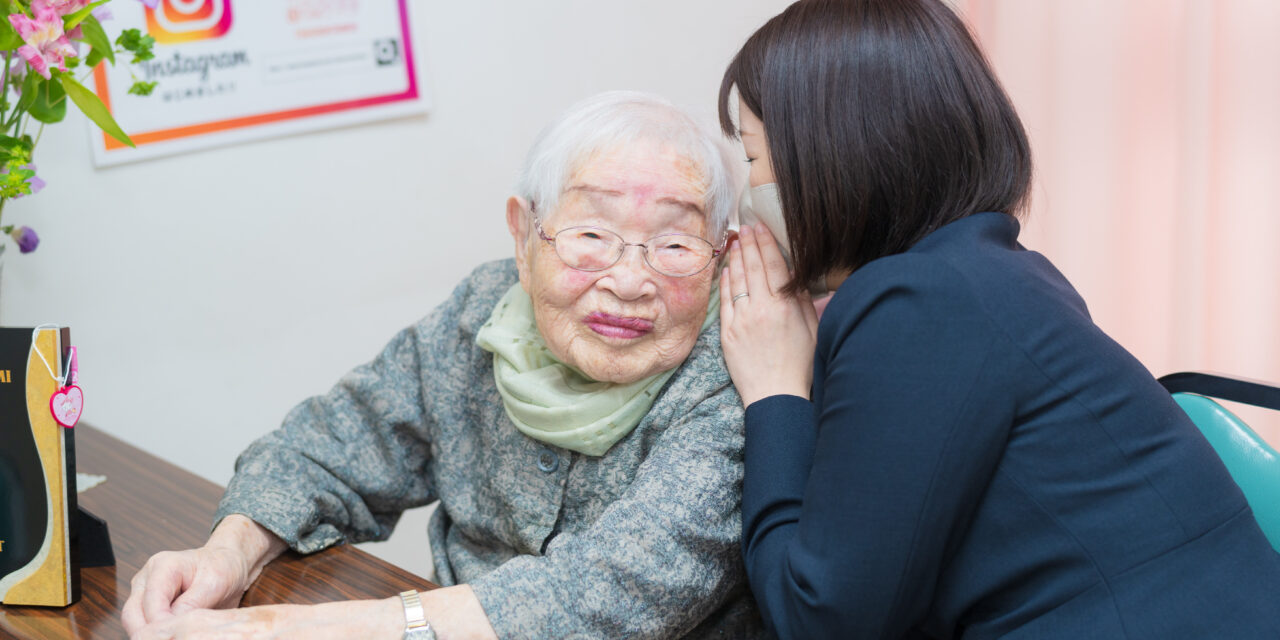We visited Mrs. Tome Mizogami, a beloved supercentenarian in Kitakyushu who lives as a shining example of longevity, to learn about her life journey and the principles she lives by at age 110.
Tome Mizogami, born 25 October 1914, lives in Kitakyushu City, Fukuoka Prefecture. At 110 years old, she continues to inspire those around her with her gentle demeanor, lively spirit, and thoughtful presence. As seen from the watch she still wears on her wrist, Mrs. Mizogami remains clearly mindful of time. She independently plans how to spend her free time each day, enjoying a fulfilling routine that includes folding mealtime aprons for other residents at her care home, writing letters to friends and family, and crafting small paper trash boxes from newspaper flyers.
During our visit on 5 April 2025, Mrs. Mizogami welcomed us wearing a handmade top of her own creation, with her makeup neatly done. At 110, her elegance and sense of independence remain deeply impressive. When asked about the secret to her health and longevity, she shared her personal “Three Principles for a Long Life”:
- Avoid quarrels or confrontations with others
-
Forget today’s troubles by tomorrow
-
Stop eating when you’re about 80% full
At our request, Mrs. Mizogami graciously wrote out her Three Principles for Longevity, carefully forming each word. Her quiet determination and steady hand reflected the same discipline and grace that have carried her through over a century of life.
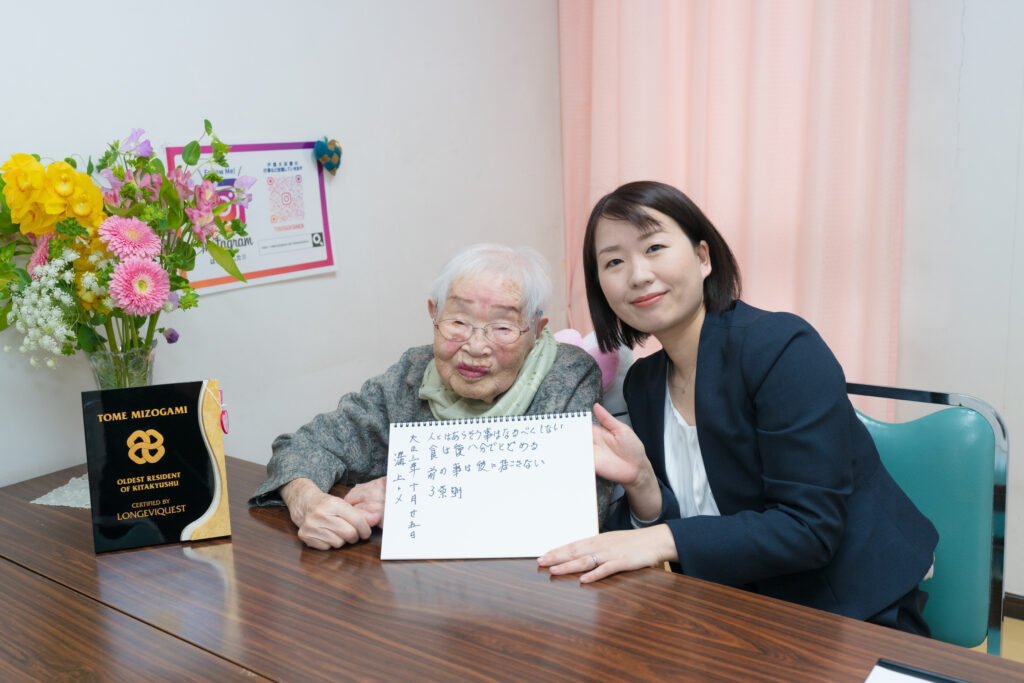
(The handwritten “Three Principles for a Long Life” by Mrs. Mizogami – shown during the LongeviQuest visit, 5 April 2025)
A Life Remembered with Precision
Mrs. Mizogami was born in the village of Tashiro, Kagoshima, as the youngest of nine siblings in a sake-brewing family. Her given name, “Tome,” means “to stop” in Japanese and was traditionally used to indicate the last child in the family. Although several of her siblings passed away young, Mrs. Mizogami and her two sisters all lived past 100, and in 2000, nearly 100 relatives and friends gathered in their hometown to celebrate the long lives of the three sisters.
After losing her mother at the age of nine, Tome was raised by her grandmother and cared for by her older siblings. She later shared that, after becoming a mother herself, she vowed to live a long life so that her children would never experience the same loneliness she had felt.
She graduated from the higher division of a rural elementary school and, driven by a strong desire to continue her studies, moved to Osaka to pursue her education at Japan’s first night school for girls. She worked in a textile factory during the day and studied at night.
At age 23, she traveled to Taiwan after receiving a telegram that her brother, stationed there, had become critically ill. In reality, her brother had arranged for her to meet a sailor from Nippon Yusen (Japan Mail Shipping Line), who would later become her husband. Shortly after their marriage, the Second Sino-Japanese War began. She gave birth to three children while living in Taiwan, though tragically, two of them passed away during infancy.
Following the war, in 1946, she and her surviving daughter were repatriated to Japan aboard an American Liberty ship, arriving at Tanabe Port in Wakayama. After a series of moves, the couple settled in Kitakyushu. After the war, she had two more sons. During the difficult postwar years, Mrs. Mizogami spent a period working night shifts at a seafood processing plant to support her family. After raising her children, she went on to run a fish shop.
During our visit, Mrs. Mizogami shared these life events in striking detail—calmly and entirely in her own words. Her vivid recollection of names, places, and the flow of time—from prewar Japan to postwar repatriation—left a deep impression on us. It is rare for a supercentenarian to offer such a clear and firsthand narrative, and her account stands as both a personal testimony and a living record of history.
Living with Purpose, Every Day
Mrs. Mizogami lived independently until the age of 109. Even in her 100s, she continued making clothes by hand. She loved cooking for herself, often preparing tempura, simmered vegetables, and other home-style dishes—and she was known for generously sharing them with her neighbors.
At 95, she replaced her old sewing machine with a new one and continued making clothes, as well as enjoying embroidery and patchwork as hobbies, until the age of 109. She climbed local hills with friends, jumped rope into her 70s, and remained physically active for as long as she could.
Her daily life was also anchored by her deep spiritual practice. She visited Mount Kōya three times in her younger days—a sacred center of Japanese Buddhism founded by the monk Kūkai (Kōbō-Daishi) and the heart of the Shingon sect. There, she prayed for long life and memorized the Heart Sutra (般若心経), which she continued to recite every morning at her home altar. As part of this gentle morning ritual, she offered five to six cups of water each day—dedicated to Kōbō-Daishi and her ancestors—a quiet habit she maintained until the age of 109.
Mrs. Mizogami lived independently with support from her grandniece—the granddaughter of one of her older sisters. When she could no longer take part in community clean-ups, she served tea to local residents instead, remaining a beloved presence in the neighborhood.
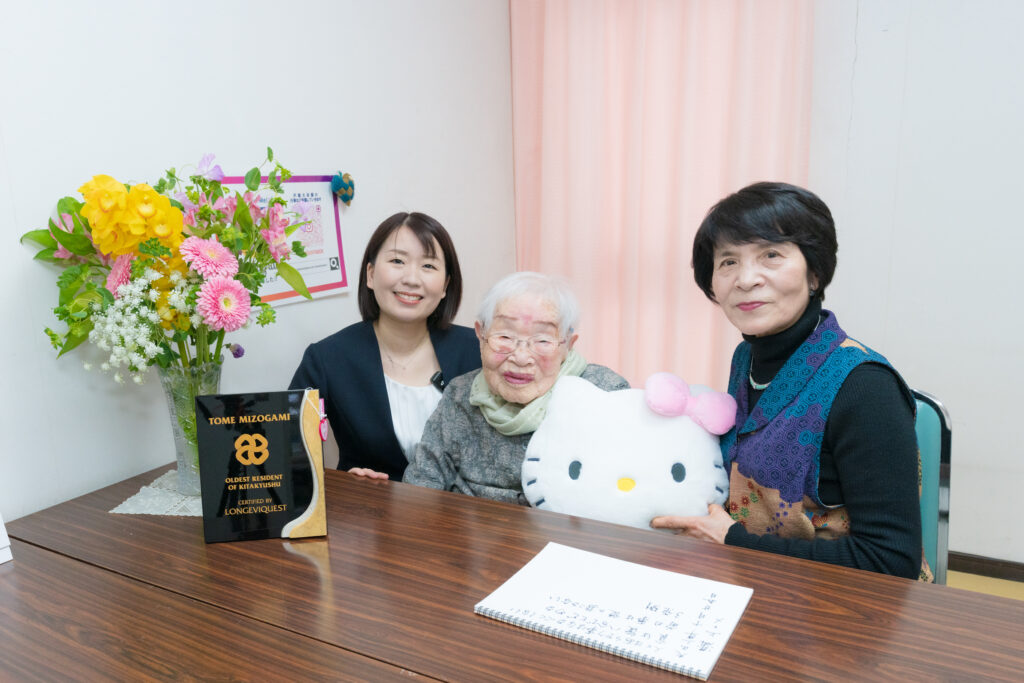
(Mrs. Tome Mizogami with her grandniece and Yamamoto from LongeviQuest Japan. – LongeviQuest visit, 5 April 2025)
A Small Gift from the Heart
As a small gesture of gratitude on behalf of LongeviQuest Japan, we brought two modest gifts during our visit:
-
A plaque recognizing Mrs. Mizogami as the oldest living person in Kitakyushu
-
A Hello Kitty cushion we thoughtfully chose to support her recovery and bring comfort—knowing her fondness for cute characters and hoping it would bring a smile
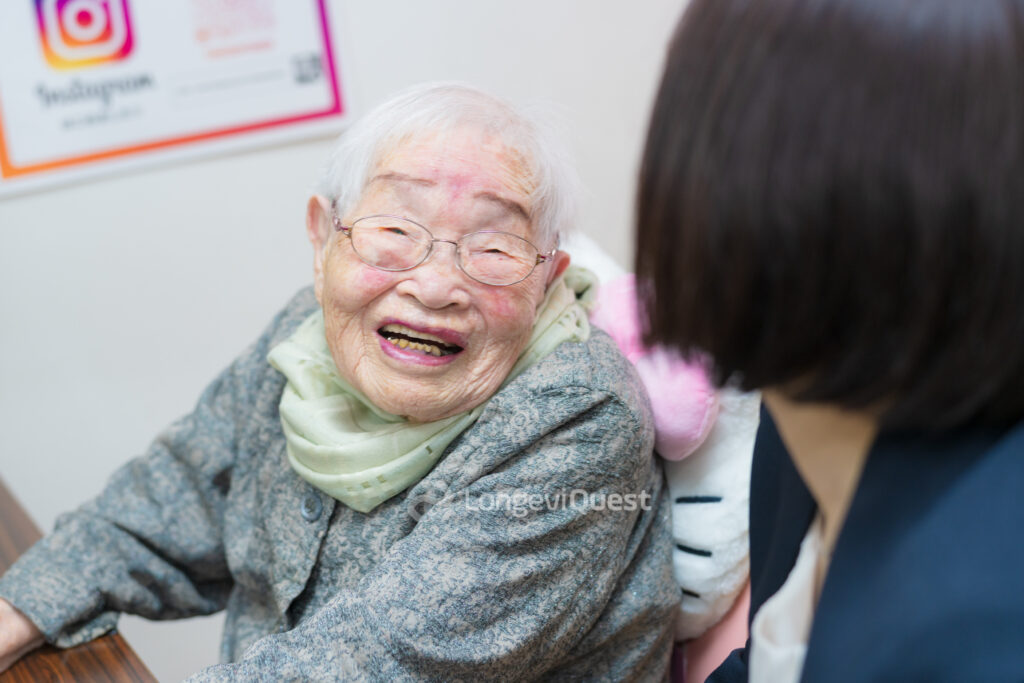
(Mrs. Mizogami smiles while leaning against the Hello Kitty cushion she received. – LongeviQuest visit, 5 April 2025)
“How cute!” she said with a delighted smile, leaning back gently against the cushion that had been placed behind her.
Resilience and Renewal at 110
At the age of 103, she experienced a major health crisis due to gastrointestinal bleeding and was hospitalized for three months. Her family was told by doctors to prepare for the worst, but she defied the odds and made a remarkable recovery, eventually returning to her normal daily life.
At 109, she fell near a vegetable field and fractured her tailbone. After regaining her ability to walk, she moved into the nursing home she had already been attending as a day-service user, seeking a safer and more comfortable environment.
In December 2024, during a mochi-pounding event at her care home, Mrs. Mizogami—then 110 years old—lifted the mallet and cheerfully joined her friends in pounding rice cakes. The following month, in January 2025, she fractured her back after falling while trying to get up from bed. She chose not to be hospitalized and instead requested to recover at the care home. Staying positive and committed to rehabilitation, she has since regained mobility and, as of April 2025, is able to walk again with the assistance of a walker.

(Mrs. Mizogami regularly practices walking with the handrail as part of her daily rehabilitation. – LongeviQuest visit, 5 April 2025)
A Voice of Living History
During our visit, Mrs. Mizogami spoke about her life with remarkable fluency—never pausing to search for words, never hesitating to recall. She shared names, places, and events from her youth through the postwar years with such clarity and calm confidence that it felt as though she were recounting recent memories. It is not uncommon for supercentenarians to reflect on their lives, but it is extraordinarily rare to meet someone who can speak so effortlessly and consistently across a century of lived experience. Her account was not only deeply personal, but also a vivid and coherent testimony that resonates as a living piece of history.
Her detailed recollections offer powerful validation of her age and the life she has lived. In a country like Japan, where the aging population continues to grow, Mrs. Mizogami’s ability to maintain both physical and mental independence up to the age of 109—and how she continues to live each day with positivity beyond the age of 110—make her a remarkable example of healthy longevity. Her way of life offers valuable insight and inspiration to people of all generations.
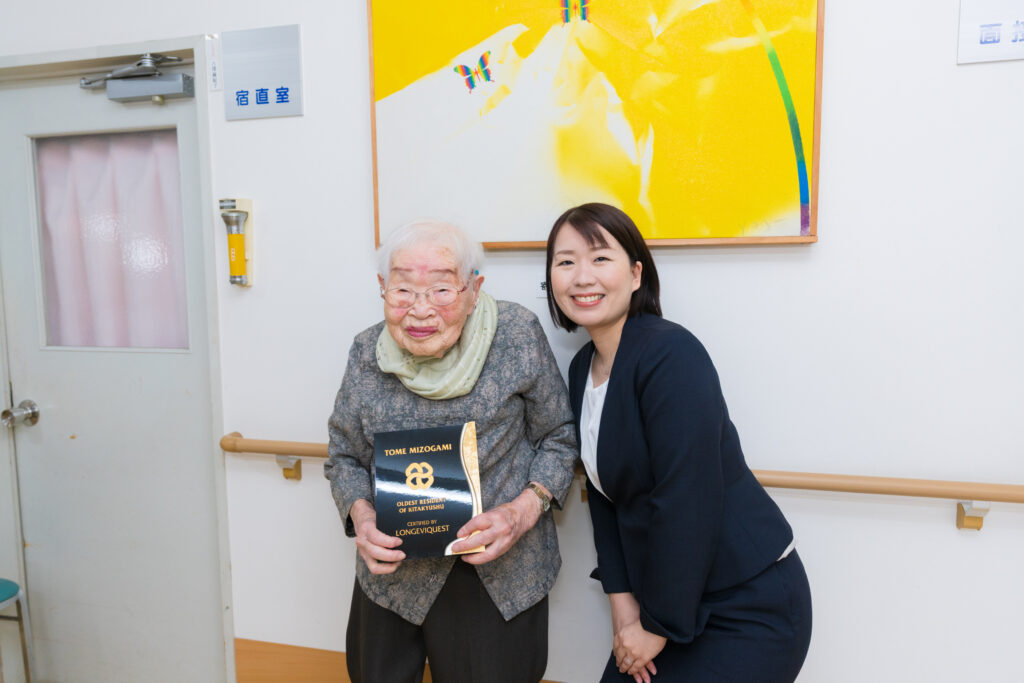
(Mrs. Mizogami stands with her plaque recognizing her as the oldest resident of Kitakyushu. – LongeviQuest visit, 5 April 2025)
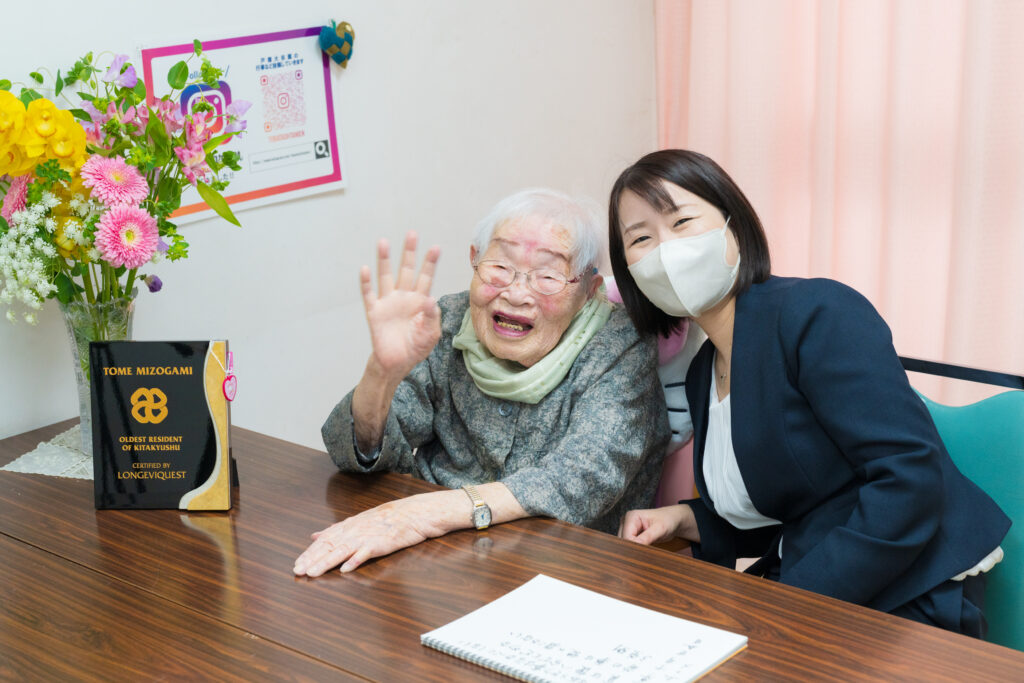
(LongeviQuest visit, 5 April 2025)
We would like to express our sincere gratitude to Mrs. Mizogami, to her family, to her grandniece who graciously accompanied our visit, and to the devoted staff of her care home. I wholeheartedly wish Mrs. Mizogami continued health and happiness—and I truly look forward to the next time we meet.

